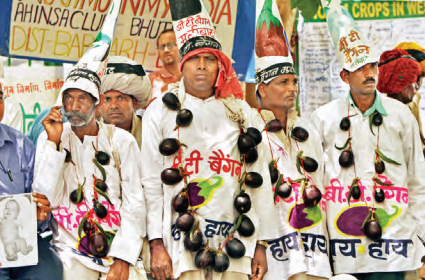The GMO cliffhanger
Biz@India
October 2019

As the farmers in Maharashtra continue to sow genetically modified varieties as a mark of protest against the ban of genetically modified organisms (GMOs), leading agricultural activists are dead against the varieties, claiming them to be a mastermind of corporate giants. As the clash goes on, the clouds of uncertainty hover over India.
It was a usual day for Jeevan Saini, a farmer in Haryana, until a car stopped by and made an unusual offer. In what was music to Saini’s ears, he was offered seeds that would grow into healthier and more aesthetically appealing brinjals, which wouldn’t get affected by pests! A greater yield, higher pest resistivity, healthier harvest, and a one-time investment— it was a dream! Lured by this magic formula, Saini instantly agreed. Little did he know that his magic beans would make headlines for all the wrong reasons, and lead him to being accused of cultivating Bt Brinjal, a genetically modified variety of eggplant, which is banned in India.
The government intervened, accused him of growing a carcinogenic variety, and made him uproot his cultivation. The poor farmer was left bereft of his harvest and given no compensation for his loss, pushing him into acute financial distress. Many like Saini have been facing a similar fate for around two decades now.
The GMO trail took an unexpected turn when around 1,000 farmers from Akoli Jahangir village of Maharashtra, decided to continue growing the varieties as a mark of protest. They stood firm against the Environment Protection Act, 1986, which described GMO cultivation as a punishable offence landing the offender behind bars for five years, in addition to a hefty fine of INR 0.1 million. Soon, the disobedience movement took over the entire state and all the Maharashtrian farmers, under the umbrella organisation, Shetkari Sanghatana, sowed seeds of defiance.
History repeating itself?
The illegal cultivation of GMOs is not new to the Indian mainland. Long before these varieties got the legal stamp of approval in 2002, GMOs were being planted in the Indian soil. In 2001, the Hyderabad-based Navbharat Seeds, a private seed distribution company, distributed Bt cotton seeds produced by Mahyco Monsanto, in the cotton-producing states, such as Gujarat. Monsanto, the America- based corporate had, and even today has a complete monopoly over genetically-modified seeds, as per the reports by the Competition Commission.
Cotton farmers, at that time, were facing the challenge of expensive chemical pesticides, which were damaging the crops as well as the soil. Loss of crops either to pests or pesticides drove the farmers into debts, with some of them committing suicide in desperation. In such a scenario, a cotton variety that would be naturally resistant to the pink bollworm (a primary cotton pest) and the American bollworm (a secondary pest induced due to excessive pesticide usage), and also give higher yields, presented the ultimate solution to all the farmers’ problems.
When the government found out about these illegal plantations, the Genetic Engineering Approval Committee (GEAC) ordered these crops to be burnt, and thus began a series of protests. Bt cotton had penetrated the Indian plantation pattern so much, that there was no turning back. Even the then Gujarat government under Narendra Modi, currently the Prime Minister of India, defied this decision, but Bt Cotton had spread too far and wide by then.
The Government gave a green signal to Bt. Even if it had banned the cultivation, Bt had already entered the Indian plantation cycle. Leading agricultural activists from across the country believe that it is because of this pressure that the Bt Cotton got approved.
“This is a case of failed and hazardous technologies that are trying to be introduced through the backdoor route, entrapping desperate and poor farmers. The ones who are encouraging farmers to opt for, and grow illegal GM seeds are actually taking an anti-national step and, in a way, this is bio-terrorism,” warns Badrinarayan Chaudhary from the Bhartiya Kisan Sangh, an Indian farmer’s representative organisation.

The GMO trail took a turn when farmers from Maharashtra, continued to grow the varieties in protest
Bt Cotton: A success or failure?
Within three years of Bt Cotton, India became one of the largest producers as well as exporters of cotton in the world. Once an importer, the Indian agricultural sector began brimming with success. The problem of pests also seemed to have been solved. Around 90 pc of the total cotton produced in India took the GMO trail.
However, as per the official data shared by the ministries of agriculture and textile, the cotton yield in 2017 was almost similar to that in 2005, when the share of Bt cotton was around seven to nine per cent, with around 400-500 kilograms per hectare, suggesting a nil growth. What comes across as even more shocking is the recently-shared data by the Cotton Association of India, according to which the cotton yield in 2018 dipped to 428 kg per hectare, which was even lower than 2005.
Adding to the problem is the resistance against the Bt toxin (a toxin present in Bt Cotton for killing bollworms) which has developed in the insects over the years. While the pink bollworm, native to India, has developed a complete resistance, the American bollworm is on the verge of the same. A 700-800 pc more active reproductive cycle and ability to move away swiftly from the fields to re-group again, gives the American bollworms an edge over the Indian ones.
One of the prime objectives of Bt Cotton was to reduce insecticide usage. However, while the modified varieties are believed to provide protection against the bollworms, they do not guarantee protection against other pests, such as jassids, aphids, whiteflies, mealybugs and mirid bugs, which had emerged due to the ecological disruption caused by rampant chemical usage.
Many activists have put forward the argument that the chemical insecticides have just shifted from bollworms to other insects. The insecticide usage hasn’t stopped. In fact, as per the data shared by the Cotton Association of India, the insecticide usage has increased over the years. Environmental activists, such as Vandana Shiva, have argued from time to time, that the rampant increase in cotton yield had more to do with increased pesticide usage than the technology itself.
Due to all these loopholes, Bt Cotton, and in fact, GMOs in totality, are facing a lot of backlash from activists around the country. For instance, Aruna Rodrigues, who has filed a public interest litigation in the Supreme Court, for GMO, explains how the GMO strikes at the future of India’s food security and food sovereignty. “The farmers were lured into GMOs. Neither were they told about insect resistance nor did they know that Bt Cotton does not have an intrinsic gene for yield. They were just told that no insect will damage their crop. It was such an irresistible proposition for them, that they couldn’t deny,” she observed.
“Monsanto has created a monopoly over the commercial supply of seeds. When they were offered Bt seeds, they thought they’ll borrow the original seeds from their neighbours, not realising that everyone had lost their seeds. The farmers had lost their seeds, the Indian companies were monopolised and the cotton research institutes, the public/government sector, and so on, had stopped supplying the seeds. There were no other seeds in the market than Monsanto’s. So, it is not that the farmers were just tempted to use such seeds, they were being left with no alternative,” adds Shiva.
“It is the best-promoted technology in the world, better than microwaves or anything else. Nothing has ever been promoted like this,” claims Rodrigues.
According to a study published in a peer reviewed journal, the Bt Cotton growing areas of Vidarbha, the eastern region of Maharashtra, where Shiva is actively involved, beneficial soil organisms have declined, undermining soil health and fertility. The result revealed a significant decline in actinobacteria (17 pc), bacterial count (14 pc) as well as acid phosphatase (27 pc), phytase (18 pc), nitrogenase (23 pc and dehydrogenase (12 pc) activities in Bt Cotton compared with non-Bt Cotton fields.
It wouldn’t be wrong to say that as the question of GMO safety plagues India, the import of edible oils, crops, fruits, frozen foods, and so on, from countries with legalised GMOs make for a valid doubt whether India is already consuming the debated varieties. While on one hand, the government is arresting farmers for cultivating GMO varieties, on the other, it is issuing statements, such as ‘there is no scientific evidence that GMOs are unsafe’ and backlashing scientists criticising the technology, while continuing to import food products. While activists like Shiva and Rodrigues are comparing it to the adversities of the Green Revolution, organisations, such as Shetkari Sanghatana are staging mass protests against the ban.
Amidst these protests and campaigns, the Indian farmers continue to live under a deepening sense of insecurity and ignorance and continue to be a victim of the vicious circle of poverty. As the governments and civil society debate, the voices of the Indian farmers, who feed the nation, are getting lost. Will India be able to sow seeds of hope or despair? Only time will tell.
Divided science fraternity
In India, the GMO varieties are required to go through an extensive series of tests at the Department of Biotechnology (DBT) before being approved for the markets. “The varieties are tested extensively at each stage for toxicity, allergenicity, how far the pollen can travel, and so on before being approved. It is only after this exhaustive process of laboratory as well as field trials that the varieties are approved. It’s a public-funded research and we do our jobs honestly. We work for the sake of science. If we receive proper scientific evidence against GMOs, we are open to their ban. However, as of now, there is no scientific evidence against them,” says a leading agricultural scientist who did not wish to be named.
The scientific community is divided on the status of GMOs. While many are wary of their effects and several others claim them to be safe, none guarantees against the possibility of any side-effect that may emerge on consumption in say, 50 years from now.
In November 2018, another leading agricultural scientist, M.S. Swaminathan, popularly known as the father of the Green Revolution, along with his counterpart, Dr P.C. Kesavan, wrote an article in the scientific journal, Current Science, expressing his concerns over the possibility of the unintended effects of GMOs. The journal not only criticised the failure of Bt Cotton to help Indian farmers increase yields and incomes, and reduce pesticide use, it also questioned the safety of GM eggplant and mustard varieties, which are being grown illegally in India for decades now.
However, the two received severe backlash from the Government. Swaminathan received a letter from Krishnaswamy VijayRaghavan, the principal scientific advisor to the Government of India, claiming his editorial to be ‘severely flawed’ and full of ‘extraordinary generalisations’. The letter further read that their results were ‘selectively omitted, selectively represented or misrepresented’.
India is, however, ready to support the GMO research, no matter what. “We are supporting (GM) research, we are supporting scientists who are working on developing platforms for it,” Renu Swarup, secretary at Department of Biotechnology asserted recently.












